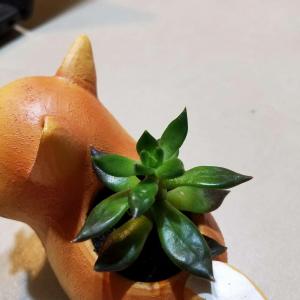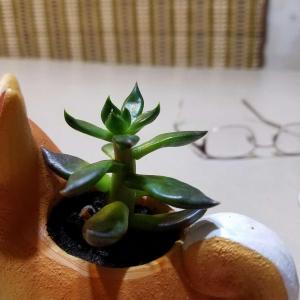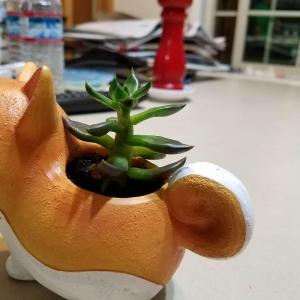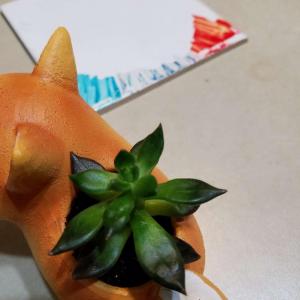文章
Dummer. ゛☀
2017年07月24日

Family - Fabaceae
Stems - To +1m tall, erect to reclining, glabrous, glaucous, green with some purplish-red at nodes, single from base and branching in inflorescence.
Leaves - Alternate, trifoliolate, petiolate, stipulate. Petiole to 5.5cm long, glabrous, slightly thickened at base for 5mm or so. Lateral leaflets ovate to oblong, acute to obtuse, entire, glabrous and shiny green above, glaucous and glabrous below or with very few hairs on midrib, to +/-8cm long, +/-3.5cm broad. Petiolules to 5mm long. Stipules at base of petiolules to 2-3mm long, linear-attenuate. Terminal leaflet similar to lateral leaflets but typically larger and on a petiolule to 2.5cm long. Petiolule glabrous.
Inflorescence - Terminal racemes or loose panicles to +40cm long. Axis pubescent. Pedicels to 1.5cm long, pubescent. Flowers 2-3 at each node.
Flowers - Corolla rose-pink, papilionaceous. Standard to 1.2cm long, 8mm broad, with two whitish spots near base. Stamens diadelphous, filaments white. Style green, 3mm long, glabrous. Ovary 5mm long, pubescent, reddish-green. Calyx bilabiate, reddish-purple. Calyx tube to 1.1mm long. Upper lip single lobed, to 2mm long, reflexed in flower. Lower lip 3 lobed. Lobes attenuate, to 3mm long, pubescent.
Loments short pubescent, with 4-6 segments.
Flowering - July - September.
Habitat - Rocky open woods.
Origin - Native to U.S.
Other info. - There are about 18 different species of Desmodium in Missouri, most are very difficult to tell apart. This species is a bit easier to tell because it has the shiny green leaves which are glabrous and glaucous below. Also, the flowers of this species are fairly large and showy for the genus. D. laevigatum can be found in the southern 1/3 of the state and prefers to grow in acidic soils on chert, sandstone, or granite.
Stems - To +1m tall, erect to reclining, glabrous, glaucous, green with some purplish-red at nodes, single from base and branching in inflorescence.

Leaves - Alternate, trifoliolate, petiolate, stipulate. Petiole to 5.5cm long, glabrous, slightly thickened at base for 5mm or so. Lateral leaflets ovate to oblong, acute to obtuse, entire, glabrous and shiny green above, glaucous and glabrous below or with very few hairs on midrib, to +/-8cm long, +/-3.5cm broad. Petiolules to 5mm long. Stipules at base of petiolules to 2-3mm long, linear-attenuate. Terminal leaflet similar to lateral leaflets but typically larger and on a petiolule to 2.5cm long. Petiolule glabrous.

Inflorescence - Terminal racemes or loose panicles to +40cm long. Axis pubescent. Pedicels to 1.5cm long, pubescent. Flowers 2-3 at each node.
Flowers - Corolla rose-pink, papilionaceous. Standard to 1.2cm long, 8mm broad, with two whitish spots near base. Stamens diadelphous, filaments white. Style green, 3mm long, glabrous. Ovary 5mm long, pubescent, reddish-green. Calyx bilabiate, reddish-purple. Calyx tube to 1.1mm long. Upper lip single lobed, to 2mm long, reflexed in flower. Lower lip 3 lobed. Lobes attenuate, to 3mm long, pubescent.
Loments short pubescent, with 4-6 segments.

Flowering - July - September.
Habitat - Rocky open woods.
Origin - Native to U.S.
Other info. - There are about 18 different species of Desmodium in Missouri, most are very difficult to tell apart. This species is a bit easier to tell because it has the shiny green leaves which are glabrous and glaucous below. Also, the flowers of this species are fairly large and showy for the genus. D. laevigatum can be found in the southern 1/3 of the state and prefers to grow in acidic soils on chert, sandstone, or granite.
0
0
文章
Dummer. ゛☀
2017年07月24日

Family - Orchidaceae
Stems - From an undivided corm. Stems to +/-65cm tall, erect, herbaceous, terete, green, glabrous, simple, single from the base.
Leaves - One well developed leaf per stem. Other leaves reduced and scale-like. Large leaf linear, acute, entire, +/-20cm long, 1cm broad, glabrous, sheathing at the base, with expressed veins below which create a somewhat pleated appearance.
Inflorescence - Terminal raceme to +20cm tall (long). Axis slightly zig-zag, glabrous. Each flower subtended by a subulate scale. Scales acute, to +/-5mm long. Flower sessile.
Flowers - Floral tube to +/-1cm long, glabrous, green to purplish. Sepals and petals pink to purplish, glabrous. Sepals acute, to +2cm long, +1cm broad, the upper 2 somewhat oblique. Lower sepal oblong to narrowly elliptic. Upper lip of the corolla hinged, deflexed, with white, yellow and orange hairs at the apex, to -2cm broad, broadest at the apex, -2cm long, with two small basal lobes. Lobes acute, 2-3mm long. Column arched and protruding from the rest of the flower, to 2cm long, stout, winged near the apex and 7-8mm broad, darker than the rest of the flower near the apex. Lateral petals to 2.2cm long, oblong-elliptic.
Stems - From an undivided corm. Stems to +/-65cm tall, erect, herbaceous, terete, green, glabrous, simple, single from the base.
Leaves - One well developed leaf per stem. Other leaves reduced and scale-like. Large leaf linear, acute, entire, +/-20cm long, 1cm broad, glabrous, sheathing at the base, with expressed veins below which create a somewhat pleated appearance.

Inflorescence - Terminal raceme to +20cm tall (long). Axis slightly zig-zag, glabrous. Each flower subtended by a subulate scale. Scales acute, to +/-5mm long. Flower sessile.

Flowers - Floral tube to +/-1cm long, glabrous, green to purplish. Sepals and petals pink to purplish, glabrous. Sepals acute, to +2cm long, +1cm broad, the upper 2 somewhat oblique. Lower sepal oblong to narrowly elliptic. Upper lip of the corolla hinged, deflexed, with white, yellow and orange hairs at the apex, to -2cm broad, broadest at the apex, -2cm long, with two small basal lobes. Lobes acute, 2-3mm long. Column arched and protruding from the rest of the flower, to 2cm long, stout, winged near the apex and 7-8mm broad, darker than the rest of the flower near the apex. Lateral petals to 2.2cm long, oblong-elliptic.

0
0
文章
Dummer. ゛☀
2017年07月24日

Family - Malvaceae
Stems - Procumbent to ascending or sprawling, hirsute and with stellate hairs, scabrous, herbaceous, to +80cm long, purplish below, green above, from a taproot.
Leaves - Alternate, petiolate, stipulate. Stipules auriculate, clasping, to 2cm long, 2cm broad, ovate or lanceolate, glabrous, with ciliate margins. Petioles to +10cm long, reduced upward, hirsute and stellate pubescent, strigose, weakly 3-sided. Blade palmately 3-5-lobed, to +/-15cm broad. Lobes often divided again. Ultimate divisions entire, acute, strigose above and below with some stellate pubescence below.
Inflorescence - Single axillary flowers on long(+15cm) peduncles. Peduncles hirsute, strigose. Flowers closely subtended by 3 linear-oblong bracts. Bracts ciliate-margined, +/-2cm long, with involute margins, not distinctly separated from calyx.
Flowers - Corolla +6cm in diameter. Petals 5, deep rose-pink with white at very base, free for most of length but united to stamen column, +3cm long, +2cm broad, glabrous, blunt to emarginate at apex. Stamen column 1.3cm tall(long). Filaments deep rose-pink. Anthers pale yellow. Styles 1cm long, deep rose-pink, at first hidden by stamen column. Ovary of 15-20 carpels in a ring to 5mm in diameter. Calyx deeply 5-lobed. Tube to 3mm long. Lobes to -2cm long, lanceolate but involute in upper half, with prominent white venation, hirsute to pilose, greenish near apex, purplish-green near base, ciliate-margined, tomentose internally near base. Fruit ring to 10mm broad, 1 seed per carpel.
Flowering - March - August.
Habitat - Prairies, open woods, roadsides, railroads.
Origin - Native to U.S.
Other info. - This is a striking plant with bright flowers which only last a day and then dry to a more purple color. It is gaining popularity in cultivation and is easy to grow.
Like I've mentioned before, this family typically has flower parts in multiples of five, (the carpels, for example), and that along with the recognition of the stamen column is a good way to start recognizing the family.
Stems - Procumbent to ascending or sprawling, hirsute and with stellate hairs, scabrous, herbaceous, to +80cm long, purplish below, green above, from a taproot.

Leaves - Alternate, petiolate, stipulate. Stipules auriculate, clasping, to 2cm long, 2cm broad, ovate or lanceolate, glabrous, with ciliate margins. Petioles to +10cm long, reduced upward, hirsute and stellate pubescent, strigose, weakly 3-sided. Blade palmately 3-5-lobed, to +/-15cm broad. Lobes often divided again. Ultimate divisions entire, acute, strigose above and below with some stellate pubescence below.

Inflorescence - Single axillary flowers on long(+15cm) peduncles. Peduncles hirsute, strigose. Flowers closely subtended by 3 linear-oblong bracts. Bracts ciliate-margined, +/-2cm long, with involute margins, not distinctly separated from calyx.
Flowers - Corolla +6cm in diameter. Petals 5, deep rose-pink with white at very base, free for most of length but united to stamen column, +3cm long, +2cm broad, glabrous, blunt to emarginate at apex. Stamen column 1.3cm tall(long). Filaments deep rose-pink. Anthers pale yellow. Styles 1cm long, deep rose-pink, at first hidden by stamen column. Ovary of 15-20 carpels in a ring to 5mm in diameter. Calyx deeply 5-lobed. Tube to 3mm long. Lobes to -2cm long, lanceolate but involute in upper half, with prominent white venation, hirsute to pilose, greenish near apex, purplish-green near base, ciliate-margined, tomentose internally near base. Fruit ring to 10mm broad, 1 seed per carpel.

Flowering - March - August.
Habitat - Prairies, open woods, roadsides, railroads.
Origin - Native to U.S.
Other info. - This is a striking plant with bright flowers which only last a day and then dry to a more purple color. It is gaining popularity in cultivation and is easy to grow.
Like I've mentioned before, this family typically has flower parts in multiples of five, (the carpels, for example), and that along with the recognition of the stamen column is a good way to start recognizing the family.
0
0
文章
Dummer. ゛☀
2017年07月23日

Family - Lythraceae
Stems - From somewhat thickened fibrous roots, erect, herbaceous, branching or simple, 4-angled (the angles rounded), green but becoming red in strong sun, glabrous, to +30cm tall.

Leaves - Opposite, decussate, linear-elliptic, sessile, tapering to the base, glabrous, entire, with a single midrib, acute to slightly rounded at the apex, to +3cm long, -1cm broad.

Inflorescence - Single sessile flower from each leaf axil. Each flower subtended by a pair of opposite minute bracts. Bracts to +/-3mm long, 1mm broad, glabrous.
Flowers - Petals 4, pink to rose, adnate at the apex of the hypanthium, orbicular, 1-2mm in diameter, glabrous, alternating with the calyx appendages. Stamens 4, adnate in the middle of the calyx tube, included. Filaments 1mm long, greenish, glabrous. Anthers yellow, .1mm long. Ovary superior, globose to subglobose, to 3mm long, glabrous, 3-locular. Placentation axile. Ovules many. Style 1, to -1mm long, glabrous. Stigma small-capitate. Calyx tube green to red (in sun), glabrous inside and out, 1mm long in flower and quickly expanding, with 4 lobes and 4 triangular appendages. Lobes acute, glabrous, mostly green, lanceolate, to +1.5mm long, -1mm broad. Appendages triangular, -1mm long and broader than long.

Flowering - June - October.
Habitat - Margins of streams, spring branches, sloughs, oxbows, ditches, moist ledges, wet areas of prairies.
Origin - Native to U.S.
Other info. - This small but attractive species can be found in the southern 2/3 of Missouri. The plant is easy to identify becasue of its tiny, 4-petaled flowers and its habitat.
Stems - From somewhat thickened fibrous roots, erect, herbaceous, branching or simple, 4-angled (the angles rounded), green but becoming red in strong sun, glabrous, to +30cm tall.

Leaves - Opposite, decussate, linear-elliptic, sessile, tapering to the base, glabrous, entire, with a single midrib, acute to slightly rounded at the apex, to +3cm long, -1cm broad.

Inflorescence - Single sessile flower from each leaf axil. Each flower subtended by a pair of opposite minute bracts. Bracts to +/-3mm long, 1mm broad, glabrous.
Flowers - Petals 4, pink to rose, adnate at the apex of the hypanthium, orbicular, 1-2mm in diameter, glabrous, alternating with the calyx appendages. Stamens 4, adnate in the middle of the calyx tube, included. Filaments 1mm long, greenish, glabrous. Anthers yellow, .1mm long. Ovary superior, globose to subglobose, to 3mm long, glabrous, 3-locular. Placentation axile. Ovules many. Style 1, to -1mm long, glabrous. Stigma small-capitate. Calyx tube green to red (in sun), glabrous inside and out, 1mm long in flower and quickly expanding, with 4 lobes and 4 triangular appendages. Lobes acute, glabrous, mostly green, lanceolate, to +1.5mm long, -1mm broad. Appendages triangular, -1mm long and broader than long.

Flowering - June - October.
Habitat - Margins of streams, spring branches, sloughs, oxbows, ditches, moist ledges, wet areas of prairies.
Origin - Native to U.S.
Other info. - This small but attractive species can be found in the southern 2/3 of Missouri. The plant is easy to identify becasue of its tiny, 4-petaled flowers and its habitat.
0
0
文章
Dummer. ゛☀
2017年07月23日

Family - Polemoniaceae
Stems - Herbaceous, decumbent, often reddish, hirsute, to 30cm long, from fibrous roots. Nodes not evenly spaced on stem.

Leaves - Opposite or whorled, sessile, subulate, to 1.5cm long, 2mm wide, green.
Inflorescence - Terminal cymose or paniculate cluster of typically 3-9 flowers.
Flowers - Corolla salverform, pinkish, rose, white, or purplish. Corolla tube to 1.3cm long. Corolla lobes 5, notched at the apex, typically obovate, 1cm long, 6mm broad, glabrous. Stamens 5, borne near base of corolla tube at different heights. Calyx tube to 5mm long, 3mm broad, hirsute. Calyx lobes 5, attenuate, 2.5-3mm long.


Flowering - March - May.
Habitat - Cultivated.
Origin - Native to the Eastern U.S.
Other info. - This is a popular little plant for rocky areas and flower bed borders. There are many horticultural varieties. The plant is perennial and does keep some green foliage through the winter. Here are some other flower colors:
Stems - Herbaceous, decumbent, often reddish, hirsute, to 30cm long, from fibrous roots. Nodes not evenly spaced on stem.

Leaves - Opposite or whorled, sessile, subulate, to 1.5cm long, 2mm wide, green.
Inflorescence - Terminal cymose or paniculate cluster of typically 3-9 flowers.
Flowers - Corolla salverform, pinkish, rose, white, or purplish. Corolla tube to 1.3cm long. Corolla lobes 5, notched at the apex, typically obovate, 1cm long, 6mm broad, glabrous. Stamens 5, borne near base of corolla tube at different heights. Calyx tube to 5mm long, 3mm broad, hirsute. Calyx lobes 5, attenuate, 2.5-3mm long.


Flowering - March - May.
Habitat - Cultivated.
Origin - Native to the Eastern U.S.
Other info. - This is a popular little plant for rocky areas and flower bed borders. There are many horticultural varieties. The plant is perennial and does keep some green foliage through the winter. Here are some other flower colors:
0
0
文章
Dummer. ゛☀
2017年07月23日

Family - Polemoniaceae
Stems - From a small woody caudex, with many fibrous roots, erect, herbaceous, single from the base, terete, glabrous, green, to +1m tall, branching only in the inflorescence.

Leaves - Opposite, sessile, decussate, linear to linear-lanceolate, appearing entire but with fine antrorse teeth on the margins, attenuate, deep-shiny green above, light green below, with a single depressed midvein (expressed below), to +10cm long, 3-9mm broad.

Inflorescence - Terminal corymbiform cyme. Each division of the inflorescence subtended by a linear subulate bract (bracts progressively reduced upward), with a few cilia on the margins or not. Pedicels to +1.6cm long, essentially glabrous.
Flowers - Corolla pinkish-purple, salverform. Corolla tube to -1.5cm long, -2mm in diameter, glabrous. Lobes 5, rounded to blunt at the apices, orbicular, to -1cm long and broad, glabrous. Stamens 5, adnate at different heights along the inside of the corolla tube. Filaments completely adnate to the corolla tube. Anthers ellipsoid, to 2mm long, yellow, included but often visible at the apex of the corolla tube. Style 1, included, to 5-6mm long, green, glabrous. Stigmas 3, yellow, +/-1.2mm long. Overy superior, green, glabrous, ovoid, 1.3mm long in flower, 1mm in diameter, subtended by a green ring-like nectary, 3-locular, with 3 ovules. Placentation axile. Calyx cylindric, 6-7mm long total, +/-2mm in diameter, of 5 united sepals. Sepals joined fro 2/3 of their length, the free portion 2-3mm long, acuminate. Sepals united by scarious-white tissue, otherwise green to red (in strong sun), glabrous in and out.

Flowering - May - June.
Habitat - Wet depressions on low woods, wet meadows, low prairies, fens.
Origin - Native to U.S.
Other info. - This attractive species can be found mainly in the southeast corner of Missouri. The plant is fairly uncommon becasue of its moist habitat.
This is a striking plant - growing to over 1 meter and having a fairly large inflorescence. The plant can be confused with other species of Phlox but has long, thin, and shiny green leaves which help to identify it.
Stems - From a small woody caudex, with many fibrous roots, erect, herbaceous, single from the base, terete, glabrous, green, to +1m tall, branching only in the inflorescence.

Leaves - Opposite, sessile, decussate, linear to linear-lanceolate, appearing entire but with fine antrorse teeth on the margins, attenuate, deep-shiny green above, light green below, with a single depressed midvein (expressed below), to +10cm long, 3-9mm broad.

Inflorescence - Terminal corymbiform cyme. Each division of the inflorescence subtended by a linear subulate bract (bracts progressively reduced upward), with a few cilia on the margins or not. Pedicels to +1.6cm long, essentially glabrous.
Flowers - Corolla pinkish-purple, salverform. Corolla tube to -1.5cm long, -2mm in diameter, glabrous. Lobes 5, rounded to blunt at the apices, orbicular, to -1cm long and broad, glabrous. Stamens 5, adnate at different heights along the inside of the corolla tube. Filaments completely adnate to the corolla tube. Anthers ellipsoid, to 2mm long, yellow, included but often visible at the apex of the corolla tube. Style 1, included, to 5-6mm long, green, glabrous. Stigmas 3, yellow, +/-1.2mm long. Overy superior, green, glabrous, ovoid, 1.3mm long in flower, 1mm in diameter, subtended by a green ring-like nectary, 3-locular, with 3 ovules. Placentation axile. Calyx cylindric, 6-7mm long total, +/-2mm in diameter, of 5 united sepals. Sepals joined fro 2/3 of their length, the free portion 2-3mm long, acuminate. Sepals united by scarious-white tissue, otherwise green to red (in strong sun), glabrous in and out.

Flowering - May - June.
Habitat - Wet depressions on low woods, wet meadows, low prairies, fens.
Origin - Native to U.S.
Other info. - This attractive species can be found mainly in the southeast corner of Missouri. The plant is fairly uncommon becasue of its moist habitat.
This is a striking plant - growing to over 1 meter and having a fairly large inflorescence. The plant can be confused with other species of Phlox but has long, thin, and shiny green leaves which help to identify it.
0
0
文章
Dummer. ゛☀
2017年07月23日

Family - Lamiaceae
Stems - To 1.5m tall, dichotomously branching above, from fibrous roots or slender rhizomes, stout, erect, 4-angled, green to purple (in strong sun), hollow, often glaucous, glabrous or sparse pubescent (especially at the nodes), fragrant.
Leaves - Opposite, decussate, petiolate. Petiole to +/-4cm long, puberulent, with adaxial groove (pubescent in groove), purple. Blade to +10cm long, 6cm broad, scabrous above, punctate, tomentoulose on veins and midrib below, truncate to subcordate at base, serrate, acuminate, fragrant.

Inflorescence - Single terminal capitate cluster of +/-75 flowers. Flowers on pedicels to 1mm long. Pedicels tomentoulose. Clusters subtended by involucre of whorled foliaceous bracts.

Flowers - Corolla bilabiate, pink. Corolla tube to -2cm long, contracted and white at base in calyx tube, pink above and tomentoulose. Upper lip to 1.5cm long, folding around stamens and style, reflexed with age, pubescent externally with long cilia at apex, glabrous internally. Lower lip to 1.7cm long, with central linear lobe (notched at apex), glabrous internally, pubescent externally. Stamens 2, adnate at apex of corolla tube, exserted from upper lip of corolla. Filaments to 1.4cm long, white, glabrous. Anthers 2mm broad, with brown-purple margin. Style to +3cm long, white below, pinkish-purple at apex, pubescent. Stigma unequally two lobed. Ovary of 4 nutlets. Nutlets to 2mm long in fruit, blackish. Calyx tube to 1cm long, -2mm in diameter, 5-lobed, puberulent, 13-ribbed (nerved). Lobes linear-attenuate, 1.1mm long, dark purple, with spreading cilia on outer margin between lobes and dense erect cilia on margin internally.

Flowering - May - August.
Habitat - Prairies, fields, open rocky woods, glade margins, thickets, roadsides, railroads.
Origin - Native to U.S.
Other info. - This striking species can be found throughout Missouri but is apparently absent in the extreme southeastern section of the state. It is an easy species to ID in the field. The brilliant, dense flower heads and pleasant fragrance make the plant a perennial favorite, literally. The plant is a big favorite among butterfly gardeners and is widely cultivated. It grows easily from seed.
The leaves have been used traditionally as medicine but today are used to flavor teas. The flowers can be used to dress up a salad or garnish a meal.
The species is sometimes broken up into different varieties but these integrate so I won't mention them.
Stems - To 1.5m tall, dichotomously branching above, from fibrous roots or slender rhizomes, stout, erect, 4-angled, green to purple (in strong sun), hollow, often glaucous, glabrous or sparse pubescent (especially at the nodes), fragrant.
Leaves - Opposite, decussate, petiolate. Petiole to +/-4cm long, puberulent, with adaxial groove (pubescent in groove), purple. Blade to +10cm long, 6cm broad, scabrous above, punctate, tomentoulose on veins and midrib below, truncate to subcordate at base, serrate, acuminate, fragrant.

Inflorescence - Single terminal capitate cluster of +/-75 flowers. Flowers on pedicels to 1mm long. Pedicels tomentoulose. Clusters subtended by involucre of whorled foliaceous bracts.

Flowers - Corolla bilabiate, pink. Corolla tube to -2cm long, contracted and white at base in calyx tube, pink above and tomentoulose. Upper lip to 1.5cm long, folding around stamens and style, reflexed with age, pubescent externally with long cilia at apex, glabrous internally. Lower lip to 1.7cm long, with central linear lobe (notched at apex), glabrous internally, pubescent externally. Stamens 2, adnate at apex of corolla tube, exserted from upper lip of corolla. Filaments to 1.4cm long, white, glabrous. Anthers 2mm broad, with brown-purple margin. Style to +3cm long, white below, pinkish-purple at apex, pubescent. Stigma unequally two lobed. Ovary of 4 nutlets. Nutlets to 2mm long in fruit, blackish. Calyx tube to 1cm long, -2mm in diameter, 5-lobed, puberulent, 13-ribbed (nerved). Lobes linear-attenuate, 1.1mm long, dark purple, with spreading cilia on outer margin between lobes and dense erect cilia on margin internally.

Flowering - May - August.
Habitat - Prairies, fields, open rocky woods, glade margins, thickets, roadsides, railroads.
Origin - Native to U.S.
Other info. - This striking species can be found throughout Missouri but is apparently absent in the extreme southeastern section of the state. It is an easy species to ID in the field. The brilliant, dense flower heads and pleasant fragrance make the plant a perennial favorite, literally. The plant is a big favorite among butterfly gardeners and is widely cultivated. It grows easily from seed.
The leaves have been used traditionally as medicine but today are used to flavor teas. The flowers can be used to dress up a salad or garnish a meal.
The species is sometimes broken up into different varieties but these integrate so I won't mention them.
0
0
文章
Dummer. ゛☀
2017年07月23日

Family - Asclepiadaceae
Stems - To 1m tall, erect, from a large crown and a deep rhizome, herbaceous but stout, typically simple, typically single from the base, to +1cm in diameter at the base, glabrous, green and sometimes glaucous, solid, with copious milky sap.

Leaves - Opposite, sessile, glabrous, entire, to +15cm long, to 8cm broad, lanceolate to oblong, green above, glaucous-blue below, with a blunt to rounded apex but with a small, triangular mucro. Midrib whitish and clearly differentiated from the other leaf tissues. Veins anastomosing about 3-4mm from the leaf margin.

Inflorescence - Pedunculate umbels from the upper leaf axils. Umbels with +/-20 flowers. Peduncles to 4-5cm long, glabrous, green. Rays of the umbel subtended by small lanceolate bracts. Bracts to +5mm long, +?-2mm broad, acute, glabrous. Rays (pedicels) purplish, +/-2cm long, glabrous.
Flowers - Petals 5, reflexed, +/-1cm long, 5-6mm broad, acute, glabrous, purplish. Sepals 5, 5mm long, to 3mm broad, acute, subulate, glabrous, reflexed, hidden by the petals. Hoods pinkish, +/-6mm long, glabrous. Horns exserted from the hoods about 4mm, converging over the anther head. Anther column to -5mm long, 4mm in diameter. Pollinia 3mm long. Terminator .8mm long, deep purple. Anther sacs -2mm long.Flowering - June - August.

Habitat - Wet meadows, uplands, river bottoms, prairies, alluvial thickets.
Origin - Native to U.S. and Canada.
Other info. - This attractive species of milkweed can be found mainly in the northern half of Missouri. The plant can be identified by its completely glabrous parts, and big flowers. The flowers are fewer in number and larger than than those of the similar A. syriaca L.
A. syriaca is typically taller than A. sullivantii and the former has hairy stems and leaves.
Stems - To 1m tall, erect, from a large crown and a deep rhizome, herbaceous but stout, typically simple, typically single from the base, to +1cm in diameter at the base, glabrous, green and sometimes glaucous, solid, with copious milky sap.

Leaves - Opposite, sessile, glabrous, entire, to +15cm long, to 8cm broad, lanceolate to oblong, green above, glaucous-blue below, with a blunt to rounded apex but with a small, triangular mucro. Midrib whitish and clearly differentiated from the other leaf tissues. Veins anastomosing about 3-4mm from the leaf margin.

Inflorescence - Pedunculate umbels from the upper leaf axils. Umbels with +/-20 flowers. Peduncles to 4-5cm long, glabrous, green. Rays of the umbel subtended by small lanceolate bracts. Bracts to +5mm long, +?-2mm broad, acute, glabrous. Rays (pedicels) purplish, +/-2cm long, glabrous.
Flowers - Petals 5, reflexed, +/-1cm long, 5-6mm broad, acute, glabrous, purplish. Sepals 5, 5mm long, to 3mm broad, acute, subulate, glabrous, reflexed, hidden by the petals. Hoods pinkish, +/-6mm long, glabrous. Horns exserted from the hoods about 4mm, converging over the anther head. Anther column to -5mm long, 4mm in diameter. Pollinia 3mm long. Terminator .8mm long, deep purple. Anther sacs -2mm long.Flowering - June - August.

Habitat - Wet meadows, uplands, river bottoms, prairies, alluvial thickets.
Origin - Native to U.S. and Canada.
Other info. - This attractive species of milkweed can be found mainly in the northern half of Missouri. The plant can be identified by its completely glabrous parts, and big flowers. The flowers are fewer in number and larger than than those of the similar A. syriaca L.
A. syriaca is typically taller than A. sullivantii and the former has hairy stems and leaves.
0
0
文章
Dummer. ゛☀
2017年07月22日

Family - Scrophulariaceae
Stems - To +1m tall, erect, herbaceous but stout, terete near the base, angled in the apical 1/2, scaberulous, puberulent, much-branched, from a big taproot, mostly green.

Leaves - Opposite, linear, entire, antrorse strigose, acute, to +3cm long, 1-1.5mm broad, slightly folded, with well developed axillary fascicles. Fascicles as long or longer than the subtending leaf.

Inflorescence - Axillary racemes in the upper 2/3 of the stem. Racemes very bracteate and the inflorescence appearing as just axillary flowers. Flowers single from each leaf (bract) axil, 1-2 per node, opposite. Pedicels 3-5mm long, shorter than or equaling the calyx, glabrous, ascending. Axis of the inflorescence angled, puberulent.
Flowers - Corolla pink, to +2cm long, 5-lobed. Corolla tube densely antrorse pubescent externally, mostly glabrous internally, contracted in the basal 5mm (the portion surrounded by the calyx). Corolla tube with pink spots and two yellow stripes internally (ventrally). Corolla lobes rounded, with pilose margins, to +1cm broad, 1cm long, spreading, the upper two pilose-bearded at the base internally. Stamens 4, didynamous, mostly included. Filaments pale pink to whitish, pink pilose, to +1cm long, adnate at the apex of the contracted portion of the corolla tube. Anthers whitish, pilose dorsally, +/-3mm long, 1.5mm broad, with two acute basal lobes. Style 1, exserted beyond the corolla and from between the stamens, pale purple basally, whitish at the apex, mostly glabrous and terete, flattened and puberulent on the margins in the apical 1/3 (the stigma). Ovary superior, green, glabrous, ovoid, to 2mm long in flower, 2-locular, with many ovules. Placentation axile. Calyx campanulate, green, glabrous, 5mm long in flower, 5-lobed. Lobes 1-1.6mm long, triangular-attenuate with a slight keel that somewhat ribs the calyx tube in the apical 1/2. Most dorsal calyx lobe slightly larger than the others.

Flowering - August - October.
Habitat - Prairies, sandy open ground, thickets, woodland edges, fallow fields.
Origin - Native to U.S.
Other info. - This striking species can be found mainly in southwestern Missouri. The plant can be identified by its big flowers (which have yellow stripes and pink spots internally), and its linear leaves which have well developed axillary fascicles. The plant is very common in states to the south and east and extends up the east coast to Maryland. This species reaches its inland northern limit in Missouri.
A synonym for this species is Gerardia fasciculata Ell.
Stems - To +1m tall, erect, herbaceous but stout, terete near the base, angled in the apical 1/2, scaberulous, puberulent, much-branched, from a big taproot, mostly green.

Leaves - Opposite, linear, entire, antrorse strigose, acute, to +3cm long, 1-1.5mm broad, slightly folded, with well developed axillary fascicles. Fascicles as long or longer than the subtending leaf.

Inflorescence - Axillary racemes in the upper 2/3 of the stem. Racemes very bracteate and the inflorescence appearing as just axillary flowers. Flowers single from each leaf (bract) axil, 1-2 per node, opposite. Pedicels 3-5mm long, shorter than or equaling the calyx, glabrous, ascending. Axis of the inflorescence angled, puberulent.
Flowers - Corolla pink, to +2cm long, 5-lobed. Corolla tube densely antrorse pubescent externally, mostly glabrous internally, contracted in the basal 5mm (the portion surrounded by the calyx). Corolla tube with pink spots and two yellow stripes internally (ventrally). Corolla lobes rounded, with pilose margins, to +1cm broad, 1cm long, spreading, the upper two pilose-bearded at the base internally. Stamens 4, didynamous, mostly included. Filaments pale pink to whitish, pink pilose, to +1cm long, adnate at the apex of the contracted portion of the corolla tube. Anthers whitish, pilose dorsally, +/-3mm long, 1.5mm broad, with two acute basal lobes. Style 1, exserted beyond the corolla and from between the stamens, pale purple basally, whitish at the apex, mostly glabrous and terete, flattened and puberulent on the margins in the apical 1/3 (the stigma). Ovary superior, green, glabrous, ovoid, to 2mm long in flower, 2-locular, with many ovules. Placentation axile. Calyx campanulate, green, glabrous, 5mm long in flower, 5-lobed. Lobes 1-1.6mm long, triangular-attenuate with a slight keel that somewhat ribs the calyx tube in the apical 1/2. Most dorsal calyx lobe slightly larger than the others.

Flowering - August - October.
Habitat - Prairies, sandy open ground, thickets, woodland edges, fallow fields.
Origin - Native to U.S.
Other info. - This striking species can be found mainly in southwestern Missouri. The plant can be identified by its big flowers (which have yellow stripes and pink spots internally), and its linear leaves which have well developed axillary fascicles. The plant is very common in states to the south and east and extends up the east coast to Maryland. This species reaches its inland northern limit in Missouri.
A synonym for this species is Gerardia fasciculata Ell.
0
0
文章
Dummer. ゛☀
2017年07月22日

Family - Ericaceae
Stems - To +60cm tall, typically some shade of green and without a great deal of bark except at very base, branching, erect to ascending(in young stems), twigs and new growth pubescent to tomentose, stoloniferous, shrubby.

Leaves - Alternate, short-petiolate. Petioles to 2-3mm long, pubescent. Blades elliptic to obovate, short-acute to short-acuminate, glabrous to pubescent and green above, tomentose and glaucous below, to +3cm long, +2cm broad. Margins appearing entire but actually crenulate-serrulate(especially in younger leaves), often reddish at very edge of margin.
Inflorescence - Flowers appearing with the new seasons leaves from terminal and axillary buds. Racemes to 1.5cm long in flower, longer in fruit. Bracts subtending pedicels obovate, to +/-3mm long, with small mucro tip, cupped. Small pair of bractlets on base of pedicel to -3mm long, glabrous, with a few cilia on margins or not, lanceolate, acuminate.
Flowers - Corolla urceolate to cylindric, 5-6mm long, 4mm in diameter, glabrous, white or with some pink, 5-lobed. Lobes recurved, acute, 1.1mm long. Stamens 10, included. Filaments compressed, antrorse pubescent, 2mm long, greenish-white. Anthers copper-colored, 2-lobed, 2mm long. Style green, included, 5mm long, glabrous. Ovary inferior, 2-locular. Calyx tube 1.7mm long, 5-lobed, glabrous, green. Lobes shallow, rounded, light green, 1mm long. Berries globose, glaucous, blue-purple, 5-6mm in diameter, tasty.

Flowering - April - May.
Habitat - Dry rocky open woods, ledges, bluffs, glades, ridges, typically in acid soil.
Origin - Native to U.S.
Other info. - This small, shrubby species is common in the lower 1/2 of Missouri. The plant produces a tasty blueberry in the summer which is enjoyed by wildlife as well as people. The plant is distinguishable from the two other Missouri blueberries by the fact that it is the smaller of the 3 species, it has leaves which are glaucous below, and the stems are typically mostly herbaceous and some shade of green. The other two species of Vaccinium in Missouri become woody very early on in their growth.
A synonym for this species is V. pallidum Ait.
When small and immature, the 3 species of Vaccinium in Missouri can be difficult to differentiate in the field. The best way to tell the species apart is by looking at the leaf venation. The venation of V. arboreum is spaced widely apart. The venation of V. vacillans is spaced fairly close together. The veins of V. stamineum are very close together and sometimes hard to see. In the photo below, the venation of all three species is shown. From left to right the species are V. arboreum, V. stamineum and V. vacillans.
Stems - To +60cm tall, typically some shade of green and without a great deal of bark except at very base, branching, erect to ascending(in young stems), twigs and new growth pubescent to tomentose, stoloniferous, shrubby.

Leaves - Alternate, short-petiolate. Petioles to 2-3mm long, pubescent. Blades elliptic to obovate, short-acute to short-acuminate, glabrous to pubescent and green above, tomentose and glaucous below, to +3cm long, +2cm broad. Margins appearing entire but actually crenulate-serrulate(especially in younger leaves), often reddish at very edge of margin.
Inflorescence - Flowers appearing with the new seasons leaves from terminal and axillary buds. Racemes to 1.5cm long in flower, longer in fruit. Bracts subtending pedicels obovate, to +/-3mm long, with small mucro tip, cupped. Small pair of bractlets on base of pedicel to -3mm long, glabrous, with a few cilia on margins or not, lanceolate, acuminate.
Flowers - Corolla urceolate to cylindric, 5-6mm long, 4mm in diameter, glabrous, white or with some pink, 5-lobed. Lobes recurved, acute, 1.1mm long. Stamens 10, included. Filaments compressed, antrorse pubescent, 2mm long, greenish-white. Anthers copper-colored, 2-lobed, 2mm long. Style green, included, 5mm long, glabrous. Ovary inferior, 2-locular. Calyx tube 1.7mm long, 5-lobed, glabrous, green. Lobes shallow, rounded, light green, 1mm long. Berries globose, glaucous, blue-purple, 5-6mm in diameter, tasty.

Flowering - April - May.
Habitat - Dry rocky open woods, ledges, bluffs, glades, ridges, typically in acid soil.
Origin - Native to U.S.
Other info. - This small, shrubby species is common in the lower 1/2 of Missouri. The plant produces a tasty blueberry in the summer which is enjoyed by wildlife as well as people. The plant is distinguishable from the two other Missouri blueberries by the fact that it is the smaller of the 3 species, it has leaves which are glaucous below, and the stems are typically mostly herbaceous and some shade of green. The other two species of Vaccinium in Missouri become woody very early on in their growth.
A synonym for this species is V. pallidum Ait.

When small and immature, the 3 species of Vaccinium in Missouri can be difficult to differentiate in the field. The best way to tell the species apart is by looking at the leaf venation. The venation of V. arboreum is spaced widely apart. The venation of V. vacillans is spaced fairly close together. The veins of V. stamineum are very close together and sometimes hard to see. In the photo below, the venation of all three species is shown. From left to right the species are V. arboreum, V. stamineum and V. vacillans.
0
0
文章
Dummer. ゛☀
2017年07月22日

Family - Tiliaceae
Stems - A tree to 40m, with a single trunk or, typically, with more than two.

Leaves - Alternate, petiolate. Petiole to 10cm long, glabrous. Blade oblique at base, acuminate, serrate, to 20cm long, lower surface lighter green than upper surface and with hairs in tufts in axils of nerves, upper surface mostly glabrous. Teeth of blade with minute cilia on margins.

Inflorescence - Axillary open pendulous cymes from new seasons growth, with 5-8 flowers. Peduncle adnate to white bract for about half it's length, glabrous. Bract to +/-8cm long, to -1.5cm broad, glabrous except for few hairs near axil with peduncle, creamy-white. Pedicels to 7.5mm long, green, 1mm in diameter, glabrous.
Flowers - Petals 5, greenish-white, alternating with sepals, 7.5mm long, 3mm broad, cupped. Stamens many. Filaments white to pale yellow, to 4mm long, glabrous. Anthers yellow, 1mm long. Style 5mm long, mostly glabrous but with tufts of hairs near base. Ovary globose, 2.1mm in diameter, tomentose, 5-locular. Sepals 5, free, ovate-lanceolate, to 6mm long, 3mm broad, greenish white, with nectary at base, (appearing as translucent hump). Fruit ovoid to spherical, 4-5mm in diameter, tomentose, with typically 1 or 2 seeds. Flowers fragrant.

Flowering - May - July.
Habitat - Moist soils along stream banks and pond margins. Also in low woods.
Origin - Native to U.S.
Other info. - The wood of this species is highly desirable for furniture making because of its soft yet strong nature and its beautiful white color.
Many cultivated varieties of the genus Tilia are planted in this state, some are from the native trees, some are the European and Asian species. All the trees are visited heavily by insects when blooming.
Steyermark lists two varieties for this species. Variety americana (pictured above) has glabrous petioles, peduncles and bracts. The leaves have hairs in the axils of the nerves. Variety neglecta has stellate and simple hairs on the lower leaf surface with the bracts and peduncles being variously pubescent.
Stems - A tree to 40m, with a single trunk or, typically, with more than two.

Leaves - Alternate, petiolate. Petiole to 10cm long, glabrous. Blade oblique at base, acuminate, serrate, to 20cm long, lower surface lighter green than upper surface and with hairs in tufts in axils of nerves, upper surface mostly glabrous. Teeth of blade with minute cilia on margins.

Inflorescence - Axillary open pendulous cymes from new seasons growth, with 5-8 flowers. Peduncle adnate to white bract for about half it's length, glabrous. Bract to +/-8cm long, to -1.5cm broad, glabrous except for few hairs near axil with peduncle, creamy-white. Pedicels to 7.5mm long, green, 1mm in diameter, glabrous.
Flowers - Petals 5, greenish-white, alternating with sepals, 7.5mm long, 3mm broad, cupped. Stamens many. Filaments white to pale yellow, to 4mm long, glabrous. Anthers yellow, 1mm long. Style 5mm long, mostly glabrous but with tufts of hairs near base. Ovary globose, 2.1mm in diameter, tomentose, 5-locular. Sepals 5, free, ovate-lanceolate, to 6mm long, 3mm broad, greenish white, with nectary at base, (appearing as translucent hump). Fruit ovoid to spherical, 4-5mm in diameter, tomentose, with typically 1 or 2 seeds. Flowers fragrant.

Flowering - May - July.
Habitat - Moist soils along stream banks and pond margins. Also in low woods.
Origin - Native to U.S.
Other info. - The wood of this species is highly desirable for furniture making because of its soft yet strong nature and its beautiful white color.
Many cultivated varieties of the genus Tilia are planted in this state, some are from the native trees, some are the European and Asian species. All the trees are visited heavily by insects when blooming.
Steyermark lists two varieties for this species. Variety americana (pictured above) has glabrous petioles, peduncles and bracts. The leaves have hairs in the axils of the nerves. Variety neglecta has stellate and simple hairs on the lower leaf surface with the bracts and peduncles being variously pubescent.
0
0














